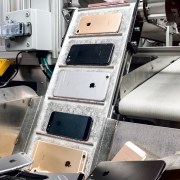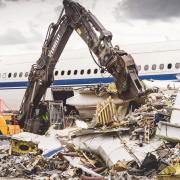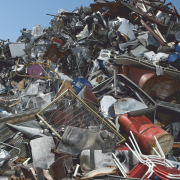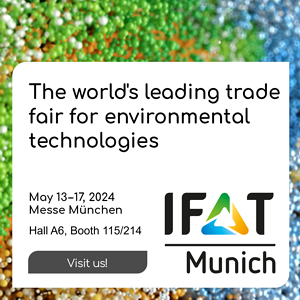European Union: On the Road to the Circular Economy
On 24 January this year, the European Parliament’s environment committee voted on the pending legislative proposals on the 2015 Waste Package put forward by the European Commission.
According to the opinion of the committee members, the share of municipal waste to be recycled should be raised to 70 percent by 2030 or prepared for reuse. For packaging materials, such as paper and cardboard, plastics, glass, metal and wood, they propose an 80 percent target for 2030, with interim 2025 targets for each material. Landfilling, which has a big environmental impact, should be limited to 5 percent, albeit with a possible five-year extension, under certain conditions, for member states which landfilled more than 65 percent of their municipal waste in 2013. Food waste in the EU is estimated at some 89 million tons, or 180 kilogram per capita per year – therefore the committee members advocate an EU food waste reduction target of 50 percent by 2030, compared to 2014. They also propose a similar target for marine litter.
According to the information, statistics from 2014 suggest that 44 percent of all municipal waste in the European Union is recycled or composted. “This compares to just 31 percent in 2004, and by 2020 EU member states should be recycling or composting over 50 percent of waste,” the Parliament stated in its press release. In 2014, Austria, Belgium, Denmark, Germany, the Netherlands and Sweden sent virtually no municipal waste to landfill, whereas Cyprus, Croatia, Greece, Latvia and Malta still landfill more than three quarters of their municipal waste.
The majority view in Europe is that improving waste management could deliver benefits for the environment, climate, human health and the economy. As part of a shift in EU policy towards a circular economy, the European Commission made four legislative proposals introducing new waste-management targets regarding reuse, recycling and landfilling in 2015, after it had decided to ditch the Circular Economy package, launched by its predecessor. As campaigners and progressive businesses had complained, despite the announcement the new proposals would be more ambitious than the previous’ ones, the targets for recycling and reducing landfill waste were weaker. According to the critics, the 2015 Circular Economy Package also fails to adequately address waste prevention by repair and reuse, and lacks a legal framework that incentivizes prevention.
Waste production and recycling
In 2014, the total waste generated in the 28 member states of the European Union (EU-28) by all economic activities and households amounted to 2.598 billion tons. As reported by Eurostat (a Directorate-General of the European Commission; its main responsibilities are to provide statistical information to the institutions of the European Union), there were considerable variations across these countries, both in the amount of waste generated and in the activities that mostly contributed to waste generation. According to latest available statistics, the average amount of waste generated across the EU-28 in 2014 was equivalent to more than five tons (5,118 kilogram) per inhabitant. On January 1, 2016 the population of the EU-28 was estimated at 510.1 million inhabitants, which were 1.8 million more than a year before, Eurostat said in its report “Key figures on Europe – 2016 edition”.
Almost two thirds (65 percent) of the total waste generated in the EU-28 was mineral waste. Construction contributed 33.5 percent of the total in 2014 (with 871 million tons) and was followed by mining and quarrying (29.8 percent or 774 million tons), manufacturing (9.8 percent or 256 million tons), households (8.1 percent or 209 million tons) and energy (3.7 percent or 95 million tons); the remaining 15 percent was waste generated from other economic activities, mainly including waste and water services (8.8 percent) and services (3.8 percent). Among the total of 2.598 billion tons of waste some 95.6 million tons (3.7 percent of the total) were classified as hazardous waste (equivalent to an average of 188 kilogram per inhabitant in EU-28).
In 2014, some 2.145 billion tons of waste were treated in the 28 European countries. “This includes the treatment of waste imported into the EU and the reported amounts are therefore not directly comparable with those on waste generation,” the European statistical authority reported. Over two fifths (43.6 percent) was subject to disposal operations other than waste incineration. A further 39.0 percent of the waste was sent to recovery operations. More than one tenth (10.8 percent) of the waste was backfilled, where backfilling is the use of waste in excavated areas for the purpose of slope reclamation or safety or for engineering purposes in landscaping. The remaining 6.5 percent was sent for incineration, either with energy recovery or without.
Significant differences could be observed among the EU member states concerning the use they made of the various treatment methods. The quantity of waste landfilled in 2014 was 16 percent lower than it had been in 2004. The quantity of waste recovered (excluding energy recovery) – in other words recycled or used for backfilling – grew by 20.1 percent from 890 million tons in 2004 to 1.069 billion tons in 2014. According to Eurostat, the share of such recovery in total waste treatment rose from 42.1 percent in 2004 to 49.9 percent by 2014. Waste incineration (including energy recovery) saw an overall increase between 2004 and 2014 of 29.6 percent and its share of the total rose to 6.5 percent. In total, the EU member states had to deal with 75.6 million tons of hazardous waste. 37.5 percent of this amount was recovered (recycled or used for backfilling) in 2014.
Circular economy and social benefits
A circular model, where products are designed for reuse, recycling, maintenance and repair, upgrading and remanufacturing, is a concept which is gaining ground in Europe. “Many studies have already shown the business case for a circular economy,” the Club of Rome stated on its homepage. “But how would a circular economy benefit society more broadly?” On that account the international think tank had begun a project which looks at the impact of a circular economy on jobs, carbon emissions and the trade balance in different European economies. “Using an input/output model and data from the World Input Output Database, the project concluded that an economy based on circular resource flows would create jobs, reduce carbon emissions and improve the trade balance,” the Club of Rome underlined.
Up to now two studies were published (www.clubofrome.org/project/circulareconomy/). The results of the first – a report exploring Finland, Sweden, France, the Netherlands and Spain – were presented in Brussels in October 2015 as an input for the European Commission’s package on the Circular Economy (December 2015). After requests from Poland and the Czech Republic a special study was done on their economies. The second report was launched in Poznan in October 2016.
In this recent study the authors Anders Wijkman and Kristian Skånberg assessed first and foremost what the likely effects would be on carbon emissions and job opportunities in the Czech Republic and Poland of the following key steps in a circular economy: Enhancing energy efficiency, increasing the percentage of renewable energy in the energy mix – and re-organizing society to enhance the overall resource-efficiency along the lines of a materially-efficient, circular and performance-based economy by:
- minimizing waste and by introducing a 25 percent overall increase in material efficiency,
- maximizing the reuse and recycling of materials by letting 50 percent of all virgin materials being replaced by secondary materials, and
- extending wealth by doubling the product life of long-lived consumer products compared to today.
“If all the different decoupling strategies would be pursued together the results would be substantial,” the authors emphasized. “As the different decoupling scenarios support and enforce each other in virtuous circles – improved resource efficiency having energy efficiency effects, and energy efficiency making it much easier to increase the share of renewable energy and cut the use of fossil fuels – the combined scenario would in reality be the easiest one to achieve.” In this case, carbon emissions would likely to be cut by more than two-thirds in the Czech Republic and Poland. The number of additional jobs would – according to the information – exceed 150,000 in the Czech Republic while the number would depend on the development of the agricultural sector in Poland. “This means that unemployment in the Czech Republic could be cut by more than half (August 2016), especially if some of the likely trade surplus gains would be used for domestic investments to boost resource efficiency in general, preferably along the lines of the investment-packages presented later on in the report. Also in Poland the unemployment rate could be reduced by moving towards a more circular economy, provided that Poland gives priority to the development of a bio-based economy, where both agriculture and forestry would play a key role.” There are also economic benefits. As reported, the improvement in the trade balance could amount to more than 2 percent of GDP (Gross Domestic Product) in both the Czech Republic and Poland. In this regard, the authors stated that there would be no trade balance gains globally. “Some countries, especially non-industrialized fuel and virgin material exporters, tend to lose when the circular economy as a concept gains broader acceptance. Over time – once economies around the world would become more resource-efficient, the benefits for early mover countries would be reduced.” But by not acting at all, the Czech Republic and Poland would probably be on the losing end when other countries would start moving towards greatly enhanced resource efficiency, the study says.
According to Anders Wijkman and Kristian Skånberg, the investments required – in addition to the normal level of investments – for moving towards a circular economy have been calculated to be in the range of 3 percent of GDP per annum – currently around five billion Euro in Czech and ten billion Euro in Poland – every year from now on until 2030. These investments would decrease unemployment with another 2 to 3 percent in the Czech Republic and Poland due to the increased domestic production the investments would lead to. “As more or less half of the total production value incurred by such investments would take place abroad, i.e. foreign firms exporting components to the investment projects, unemployment would come down in other countries as well,” the authors of the study underlined. This would mean that for every EU member state deciding to embark on an investment package like the one described, “there will be positive employment effects in the EU as a whole. This is a natural consequence in an open-market trading-zone like the EU.”
______________________
A Welcome Change
On March 14th, 2017 the European Parliament has opted to follow the ambitious lead set by Environment committee’s vote on the Circular Economy package in January this year.
According to the Confederation of European Paper Industries’ (CEPI) opinion, the Parliament had “fully grasped the opportunity to make the Circular Economy work for Europe by enabling industry and local authorities to better target where investment needs to take place,” CEPI Director General Sylvain Lhôte was quoted. The association would recognize that the new recycling targets are ambitious while providing new opportunities in terms of improving quality.
“For an industry where over half of our feedstock comes from paper for recycling, the Parliament’s approach means greater use of raw materials whilst putting the emphasis on quality,” CEPI Raw Materials Director Ulrich Leberle commented. According to CEPI, the vote to encourage the use of bio-based packaging also demonstrates the importance of a Circular Economy that builds upon Europe’s wealth of renewable resources while accelerating the transition towards a low-carbon economy. Finally the continued assertion of the separate collection of paper is viewed by the European paper and board industry as a means to bridge ambitious targets with higher quality recycling.
______________________
Study: Top Performers in Separate Collection
Last year, the European Commission presented a study assessing the current separate collection schemes in EU-28 with examples of best practices. The result: Separate collection is a legal obligation in Europe, but improvements are needed to help speed the transition to a more circular economy. The cities topping the list were Ljubljana (Slovenia), Tallinn (Estonia) and Helsinki (Finland) with collection rates as percentage of total municipal waste generation of 55.4 percent, 47.2 percent and 38.6 percent respectively.
“Good waste management is a vital element in setting the economy on a path of sustainability, together with sustainable product policy, “ the European Commission stated. “Separate waste collection plays a key role in this transition, as it increases recycling rates, minimizes the amount of waste that is sent for disposal, and moves Europe closer to zero waste. By doing this, it can also cut CO2 emissions and save virgin resources.”
______________________
Business Opportunities through eTendering
According to the European Union, eTendering is an eProcurement platform based on EC directives where Contracting Authorities and Economic Operators can perform their daily eProcurement activities. “Allowing access to a Call for Tenders related documentation such as contractual documentation, technical specifications, annexes, questions and answers, the eTendering represents a very effective extension to TED (Tenders Electronic Daily), the online version of the ‘Supplement to the Official Journal of the European Union’. The business transaction is processed under a secure environment and in an efficient way. eTendering is the most cost effective way to perform tendering – all the proposed services are free of charge.”
Interested persons can find EU tenders for the waste sector under the CPV code “Environment and Sanitation”.
https://etendering.ted.europa.eu/general/page.html?name=home
http://ted.europa.eu/TED/main/HomePage.do
______________________
Photo: ramonespelt / fotolia.com
GR12017











